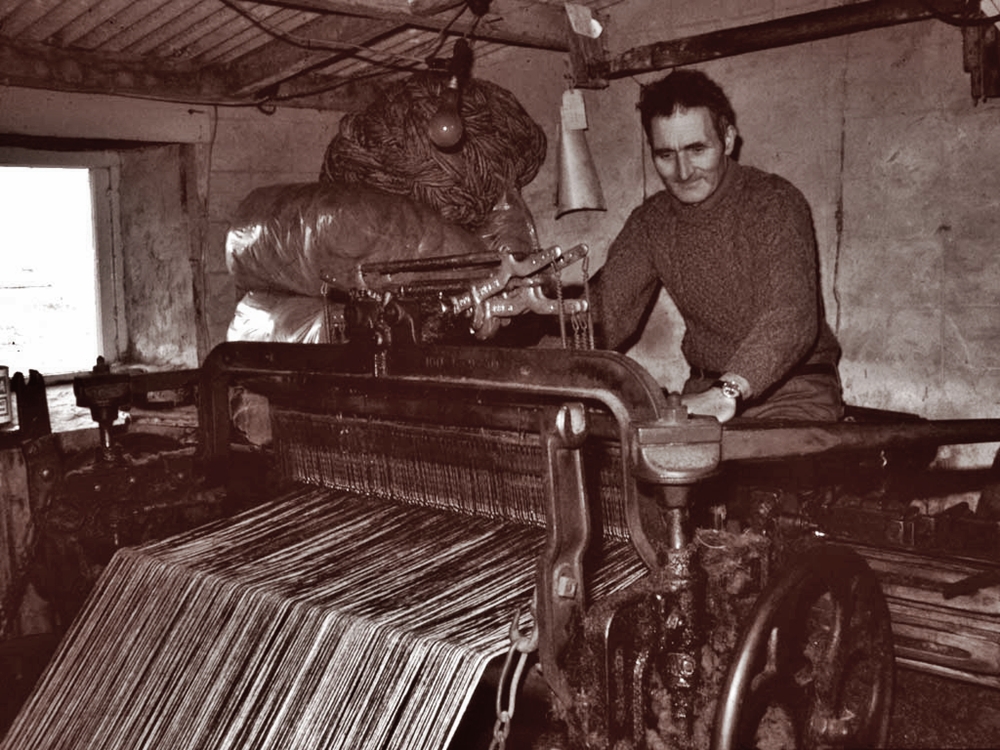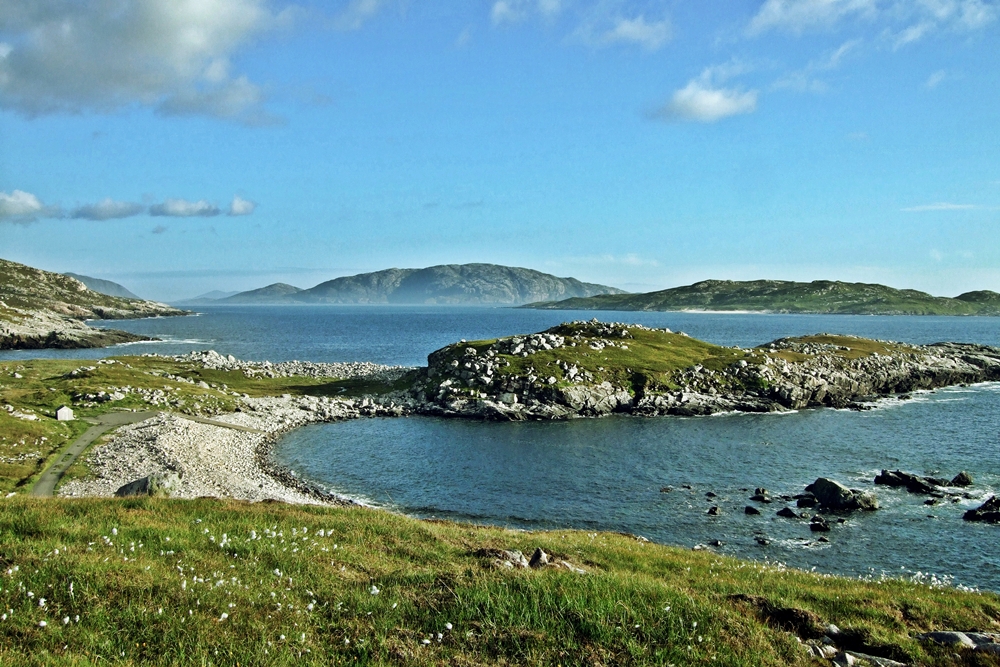Author: admin (page 21)
Waiting for the Barlow
The Hattersley Loom
Dol’ol at the loom (photo by John Blair). From an article for Uig News by Dave Roberts:
After the First World War there were ex-servicemen who had lost a hand, and one of the reasons for introducing the Hattersley domestic semi-automatic treadle powered loom to the island, was to give them an opportunity to make a living for themselves. Originally designed for the Balkans, Turkey and Greece, these looms eventually caught on for everyone in Lewis and Harris, because of the superior speed of cloth production and the more intricate patterns they could weave. Lord Leverhulme’s interest in the industry, coupled with the serious decline of the herring fishery and the poor price of cured fish from the long line fishery, meant that weaving became a much more important part of the island economy. He had great plans to build weaving sheds close to townships to house a number of Hattersley looms. The weavers would be employed from nine to five, six days a week, weaving tweed for a wage. However this arrangement did not suit crofter-weavers, who would only weave when the croft work allowed, and the idea was eventually dropped.
Hugh Mackay, Carishader, bought the very first Hattersley loom in Uig; it was a single shuttle model. He was a marine engineer, trained in Glasgow, and could strip down the loom and reassemble it without difficulty. If he had a problem, he had no one locally to ask for advice, so he would get on his motorbike and go to Stornoway. However he admitted that quite often he had forgotten the solution, by the time he got back home! In 1936, John Buchanan of No7, Valtos, organised a meeting at Valtos school for local people. Pat Skinner from Kenneth Mackenzie Ltd was there and they arranged for Alasdair Hare from Lochs (mac piuthair Tharmoid Doinn), known as ‘am Breabadair’, to stay in the village for a few weeks. He went from shed to shed teaching as he went.
The Cave of Swords
Rev David Watson’s Boundary Dispute
David Watson was ordained as minister of Uig in 1845 but as the congregation had mostly migrated to the Free Church, his Church remained largely empty. He was at odds with the people and the estate, as the following notes in the 1851 diary (published by Acair) of the Chamberlain John Munro Mackenzie attest:
Thursday 13 February
Walked to the Manse of Uig and found Mr Watson busy planting potatoes and clearing his arable land of Stones with a number of men employed. Went to the Parish School [at Taigh Chiosamuil] & found it quite crowded there being more than 40 scholars present, and on enquiring the cause was told that Mr Watson gave notice to the people that unless they sent their children to school he would pindfold every sheep & cow of theirs he found on his grass – He expects to get the parents to attend his Church in the same way but I fear he will be disappointed.
Monday 24 March
Went to office and was engaged meeting parties viz… Rev Mr Watson regarding claim for damages for not clearing his farm of Mr Mitchell and small tenants at Whitsunday last, tho’ he agreed and wished to accommodate Mitchelll – Got him to sign a Minute drawn up by Mr [Donald] Munro agreeing to withdrawing his claim & promised to give him the small place of Miavaig which lies into his farm, there are three small tenants here at present occupying it who can be removed to Carishader in place of those going to America.
Thursday 15 May
Went to office and was engaged meeting & paying Ministers Stipends & Schoolmasters salaries — The Rev Mr Watson produced a most extraordinary a/c of £31 made up of various idle claims for damages for mans not being repaired, damages to pasture etc etc which I denied & refused payment in toto and stated to Mr Watson my surprise at his presenting such an a/c – He replied that he would not have done so but that he was hard pressed for cash, having to pay the whole of his stipend for his stock, I offered to give him some delay in the payment of £20 to £30 if he withdrew the a/c which he refused but wished to refer it which I refused as I considered the whole to be absurd –
Home Leave 1917
Religious Instruction at Lochcroistean
Lochcroistean School 1934 – the Boys
Tarmod Mòr
Early Weaving in Uig
Donald Càm’s Early Career
Lochcroistean School 1934 – the Girls
Whisky Galore at the Upper End
Mac an Irish
Wild Murdoch of Mealista Island
Mealista Island (on the right) from above Molinish, with Scarp in the distance.
From “Various Superstitions in the North-West Highlands and Islands of Scotland, Especially in Relation to Lunacy” by Arthur Mitchell AM MD, Deputy Commissioner for Lunacy in Scotland, Corresponding Member of the Society of Antiquaries of Scotland. From the Proceedings of the Society of Antiquaries of Scotland, vol IV, published in Edinburgh in 1862. Excuse the non-pc approach:
There is a little island called Mealista, separated by a narrow seaway from the coast of Uig, without any permanent population, but to which, in former times, people resorted for the two or three summer months, to look after cows which they transported to it for the sake of pasturage. Tradition says of this island that no one was every born on it who was not from birth insane, or who did not become so before death. In the last generation, three persons had the misfortune for the first time to see the light of day on this unlucky spot, and all three were mad.¹ Of one of them, who is remembered by the name of Wild Murdoch, many strange stories are told. It is said that his friends used to tie a rope around his body, make it fast to the stern of the boat, and then pull out to sea, taking the wretched man in tow.²
The story goes that he was so buoyant that he could not sink; that they “tried to press him down in the water”; that he could swim with a stone fastened to him; that when carried to the rocky holms of Mealista or Grianan, round which the open Atlantic surges, and left there alone, he took to the water, and swam ashore; and that, when bound hand and foot and left in a kiln, by a miracle of strength he broke his bonds and escaped. It was thus they are said to have treated him during his fits of maniacal excitement; and there are many still alive [in 1862] who saw it all, and gave a helping hand.



